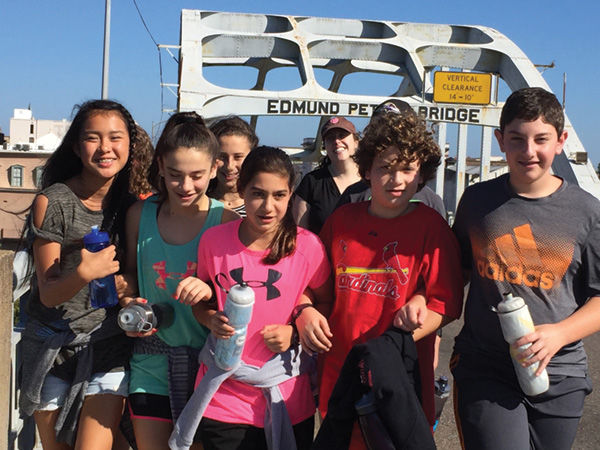Mirowitz students walk in the footsteps of Civil Rights Movement pioneers
Published September 28, 2016
Forty-two students at Saul Mirowitz Jewish Community School were able to learn more about the history of the Civil Rights Movement during a recent trip through America’s Deep South.
“During that time, people still came together to fight for what they believed in even if they were a different religion or a different race,” said sixth grader Sophia Ohrenstein. “They still came together.”
The five-day trip, which included the cities of Memphis, Selma, Birmingham and Montgomery, was part of an ongoing social justice education project now in its fifth year at Mirowitz. Each year, the entire middle school embarks on an extended journey focused around one of three given topics, which rotate in order from year to year — hunger/poverty issues, civil rights and the environment.
ADVERTISEMENT
“We’re trying to instill in them a sense of purpose,” said Head of School Cheryl Maayan.
Maayan said that Jewish themes pervade the curriculum including both Jewish involvement in the Civil Rights Movement and parallels with the Jewish people’s own struggles against oppression.
“They begin to see themselves in the stories,” she said.
Maayan, who was along for the trip, said that the students were definitely changed.
“The kids were profoundly moved by the experience,” she said. “There were moments when they were visibly emotionally confused or shaken.”
Not all of those moments were in the lesson plan. She noted that the children were surprised by the number of Confederate flags they saw while traveling through Alabama. They were also affected by their visit to the Edmund Pettus Bridge, site of a 1965 civil rights march in Selma which became known as “Bloody Sunday” after it was met with brutal force by police.
ADVERTISEMENT
The Mirowitz kids were stunned to learn that the bridge still bears the name of Pettus, an ardent segregationist and Confederate general.
“They were really upset about that and some of them are still talking about it,” Maayan said. “Here we have an important historical monument named after a member of the Ku Klux Klan.”
Sixth grader Ilana Boyer said it felt interesting to see how the bridge seemed so ordinary now despite the events which occurred there.
“Walking across the bridge, you see cars driving down it like nothing happened,” Ilana said, noting she and her classmates had linked arms and sung songs as they crossed the historic span.
The 11-year-old B’nai Amoona congregant said she was also interested in what she saw in Birmingham, where the Children’s Crusade protest was put down by the infamous Bull Connor using fire hoses and dogs in 1963. She was impressed by the bravery of the marchers.
“What they did was amazing,” she said.
Olivia Riutcel, 12, said she also thought of Connor’s police dogs, especially while walking though an area with a wall sculpture in which canine figures protrude out at pedestrians. The seventh grader said her heart began to race.
“It was scary how the dogs were jumping out and they were so close,” said Olivia, of Webster Groves, who attends Agudas Achim Beth Israel in Belleville. “I could just imagine feeling their breath on my skin.”
Sophia said she enjoyed the Birmingham Museum, which had information on both the non-violent movement of Martin Luther King, Jr. and the more militant views favored by Malcolm X. She found the exhibits informative.
“It was in chronological order and you could see how everything happened and affected other events,” she said.
Sophia, 11, was moved by artifacts from a church bombing including shrapnel taken from the skull of a young victim.
“It was really life-and-death situations,” said the Young Israel congregant who lives in University City. “Even innocent little girls got killed for the color of their skin.”
She also saw replicas of segregated drinking fountains. The one for whites was new and well-kept while the other was rusty and in disrepair.
“It was a representation of the difference in how they treated whites and African-Americans,” said Sophia, who later wrote a poem on the two fountains as part of an assignment.
Tal Recht, 11, said the experience was deeply meaningful. He said they had learned a lot in St. Louis before leaving.
“But once we got there and saw everything, we really understood what actually happened and really felt how it happened,” he said.
Tal recounted a talk in Birmingham from a National Civil Rights Institute speaker who asked if students would participate in a march knowing it might get their parents fired from their jobs or cause them to lose their homes. The speaker also asked if the students would attend a rally knowing they might be risking their lives.
“Some people said yes and some said no,” Tal said. “Back then it was much harder to make that decision than it is right now. Back then you could actually see things that were going on.”
Maayan said that students will now create a project to help make the world a better place and that the school is exploring partnerships which might help them to expand their cultural horizons.
“We’re talking both with a school in Ferguson and a school in Jennings to connect our students with other students and have opportunities for them to build relationships across difference,” she said.
Regardless, she feels that the children now have a more solid understanding of social justice issues.
“We hope that the students will come back with a fire in their belly knowing that there are problems in the world that need fixing and that they have the power to help fix them,” she said.
















